Cross-linked multilayer porous polymer membrane battery separators
a technology of porous polymer and battery separator, which is applied in the field of two-layer and three-layer, porous polyolefin separator membranes for, can solve the problems of vehicle batteries that may experience significant heating, thin electrodes and separator elements of each cell also experience heating, and are subjected to many repeated discharge and re-charge cycles. achieve the effect of improving the compatibility of the surfa
- Summary
- Abstract
- Description
- Claims
- Application Information
AI Technical Summary
Benefits of technology
Problems solved by technology
Method used
Image
Examples
Embodiment Construction
[0015]Thermoplastic polyethylene and polypropylene materials have been widely used as separator membranes in lithium-ion electrochemical cells because these thermoplastic materials are chemically and electrochemically very stable, inexpensive, and easy to process. But as the batteries have become larger and found use in automotive vehicles to power traction motors, improving battery abuse tolerance (including physical damage) has become more critical. This has led to efforts to develop thermally stable separator membranes. In practices of this invention, use is made of cross-linkable polyethylene polymers, and / or cross-linkable polypropylene polymers, and / or cross-linkable copolymers of ethylene and propylene to increase the temperature resistance of the thin layer separators used in higher power battery applications. While it is recognized that such cross-linkable polymers may continue to work well at higher cell operating temperatures, consideration must also be given as to how th...
PUM
| Property | Measurement | Unit |
|---|---|---|
| temperatures | aaaaa | aaaaa |
| thickness | aaaaa | aaaaa |
| weight percent | aaaaa | aaaaa |
Abstract
Description
Claims
Application Information
 Login to View More
Login to View More - R&D
- Intellectual Property
- Life Sciences
- Materials
- Tech Scout
- Unparalleled Data Quality
- Higher Quality Content
- 60% Fewer Hallucinations
Browse by: Latest US Patents, China's latest patents, Technical Efficacy Thesaurus, Application Domain, Technology Topic, Popular Technical Reports.
© 2025 PatSnap. All rights reserved.Legal|Privacy policy|Modern Slavery Act Transparency Statement|Sitemap|About US| Contact US: help@patsnap.com



